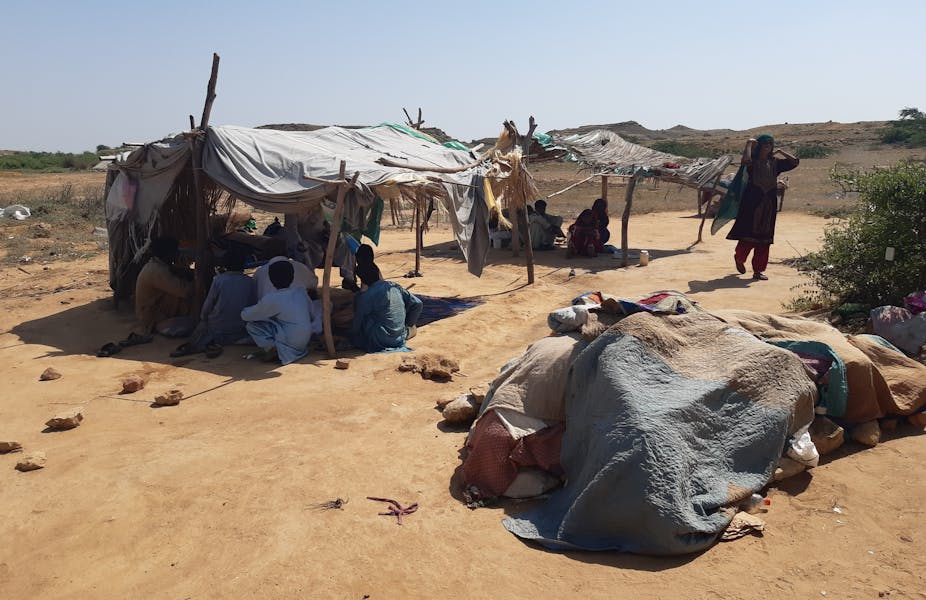Abu Bakr’s family had packed up their improvised tents in Sindh, south-east Pakistan, by mid-October 2019. Three months earlier, they had lost their houses and fields due to uncharacteristically heavy monsoon rains. Now they were returning to their village near the settlement of Mirpur Sakro to rebuild their homes. But any hope that the family could return to normality might turn out to be short-lived.
The family lives off what it grows, selling any excess produce and the occasional buffalo at the market to obtain cash for supplies or healthcare. Except that by mid-March, many of Sindh’s markets were closed because of COVID-19.
I met Abu Bakr during my ongoing research into the risks and vulnerabilities of displaced populations to zoonoses – diseases transmittable between animals and humans. In Pakistan, internally displaced populations such as Abu Bakr’s family often depend on movement to keep safe during the monsoon, for livestock grazing and the occasional seasonal work.
As they share their living, cooking and washing spaces with their livestock, zoonoses are a real concern. Even if it’s rare for these diseases such as COVID-19 to move from animals to humans, endemic zoonotic and other infectious diseases are common among displaced populations. If people are displaced from their homes, they may become more vulnerable because of their changing environment, the limited availability of services such as healthcare, and the inadequate supply of food or its poor preparation.
Displaced people are also more at risk of COVID-19, since prevention measures such as physical distancing are less effective in crowded relief camps where large households live in small shelters. Regular hand washing is often impossible without a sufficient supply of clean water.
The lockdowns are disproportionally affecting the world’s poor and displaced populations in other places too. In Karachi, Afghan refugees have been unable to access work due to movement restrictions imposed by a curfew. The effect on their livelihood is increasingly becoming a risk to their health.
In Jordan, host to one of the world’s largest refugee populations, the government closed its borders early in the pandemic. It also imposed strict curfews, restricting access to refugee camps from outside visitors, which affected how much aid was available to its inhabitants.
Read more: Coronavirus puts class dimension of mobility into sharp focus
Health trade-offs
Some humanitarian agencies shut down non-essential programmes as a result of the pandemic. For example, nutritional programmes targeted at refugees and displaced people – essential to people’s immune response – were affected.
Syrian refugees in the Zaatari refugee camp in Jordan are struggling to meet basic needs as they can no longer leave the camp to work. Their poor nutrition will inadvertently increase their vulnerability to disease. It doesn’t help that livestock are often not allowed in formal relief camps, since they could contribute to people’s livelihoods and food, improving nutrition.

In late March, the UN launched a US$2 billion (£0.9 billion) COVID-19 humanitarian response plan urging donors not to neglect funding to ongoing emergencies – including refugee and displacement crises. It stressed that providing basic healthcare and preventing overlapping health conditions are essential in limiting the severity of disease.
But health programmes are already being affected by the crisis. In April, the WHO’s Strategic Advisory Group of Experts on Immunisation advised countries to suspend mass vaccination campaigns. Early reports suggest that polio cases in Sindh have increased, a situation bound to worsen due to the lack of vaccinations. This could have far-reaching and long-term negative effects in the region.
Other efforts to control disease will be affected by COVID-19 too, as healthcare systems get overwhelmed, limiting access to health clinics and the supply of medicines. In Jordan, humanitarian health support provided through urban health clinics to the refugees, most of them Syrian, living outside the camps, has been suspended.
Abu Bakr’s family suffers from seasonal malaria outbreaks – important when one remembers that reduced access to anti-malarial health services and mosquito nets in west Africa during the Ebola outbreak caused more deaths than the virus itself.
Look to the long term
Indiscriminately implementing standard prevention measures against COVID-19 or other zoonotic disease in countries with limited resources, complex emergencies or high levels of displacement has life-threatening consequences. Government policies and humanitarian responses need to address immediate health needs, as well as long-term livelihoods and food supply.
It’s long been an ambition of humanitarian and development agencies to include migrants, refugees and displaced people in the delivery and design of aid operations. Today’s restrictions on international and local movement reiterate the importance of shifting responsibility of humanitarian responses to local groups. In Sindh, local leaders are already actively increasing COVID-19 awareness among communities.
Read more: Why refugees are an asset in the fight against coronavirus
Soon Abu Bakr will have to decide how to safely protect his family and their livestock from the monsoon floods as well as COVID-19. Trade-offs between health risks and livelihoods need to be carefully negotiated. One way to do this would be to use data on levels of poverty and coping mechanisms to contribute to models of how diseases spread. Wherever possible, researchers developing such models and responses to zoonotic diseases should get displaced populations to participate as much as possible. The weakest populations need to be supported to protect the global health of all of us.

